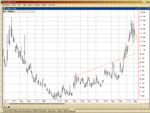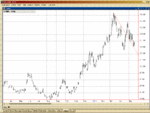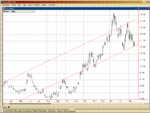By Susan Buchanan
Of Dow Jones Newswires
NEW YORK (Dow Jones)--The already-jittery U.S. coffee industry is
preparing for another Brazilian winter and further price jolts after the New York Board of Trade futures market surged in March, according to industry
members.
Donald Schoenholt, president of New York-based Gillies Coffee Company, the oldest American roasting firm, said with recent ups and downs in prices, the world has spun out of control for the U.S. industry.
The frost watch in top-producer Brazil starts in late May and continues into August.
Brazil had a devastating freeze on July 17, 1975 - known as the Black Frost - that trimmed its 1976 crop by two-thirds. "When planes flew over the coffee area, instead of seeing the usual green tracts, growing areas were black," Schoenholt said.
Two other major frosts occurred in June and July 1994. Since then, Brazilian trees have gradually been moved out of frost-prone
Santos and Parana, and up into Sul de Minas in Minas Gerais and Cerrado. Chances of a devastating freeze are lower today than they were a decade ago, but the futures market can still react dramatically to any hint of cold weather, Schoenholt said.
Frost is still nothing to sneeze at, since beans could be fine after a freeze, but trees are affected for next year's crop. If groves need to be replanted, it takes three to five years for them to bear fruit.
The market is "just coming out of a tragic, five-year crisis of
historically low prices, that left quality beans in short supply, "Schoenholt said. "Prices turned around dramatically in the last eight months or so as money managers flocked to commodities, with the stock market in the doldrums and low ret on most investments."
The Nybot May coffee contract rallied from $1 a pound in January to a more than 5-year high of $1.3950 in March, only to set back and surge again. The
most-active July contract closed at $1.2780 on Friday.
"We're seeing 5% price moves in a day, something that was unheard of in
earlier years, and it's not really related to the buying and selling of coffee
or to market fundamentals," Schoenholt said.
Large roasters "price-fix" before Brazil's winter, buying futures
contracts to offset the physical coffee they bought. "The big companies - P&G
(Procter & Gamble), Kraft and Sara Lee - have the banking arrangements,
financial stability and company minds to protect themselves," Schoenholt
observed. Small roasters by contrast don't have the cash to buy 37,500 pounds
of coffee, the equivalent of a futures contract, much less the banking
accommodations or the staff to manage a hedge program.
Adding to current industry concerns are logistics woes in Sumatra,
Indonesia, where prices are up 70% since the December tsunami, he said. A
series of earthquakes cut phone lines, damaged roads and sent workers
scattering, though trees themselves were unscathed.
Schoenholt is a founder of the 3,500-member Specialty Coffee Association of America - started in 1983 and representing gourmet coffee growers and dealers - and was voted Coffee Man of the Year in 1998.
World Supplies Tight Heading Into Brazil's Winter
"The main reason prices have risen is that we're expecting an 8-million to 10-million-bag deficit in the world balance in 2005-06," because of the smaller Brazilian crop, said Rodrigo Costa, trader with Fimat USA in New York. "With a threat of cool weather in Brazil in June or July, futures can scale $1.50.
If there's frost damage, any prediction is science fiction, but we could get above $3, $3.50 or $5 to uncharted waters. No one really knows."
Without cold weather, however, the Nybot futures market will erode in August under the weight of the advancing Brazilian harvest and could gradually back down to $1, Costa said.
Brazil's new crop, harvested from May to September, is seen at 32.46 million 60-kilogram bags, below 38.7 million last season, according to the government's National Commodities Supply Corp. on Friday.
Chance of Frost Greater Than Normal
The last significant frost event in Brazil's coffee areas was in 2000 and the last major freeze was in 1994, observes Drew Lerner, president of World Weather Inc. in Kansas. Three significant freezes, including one major one, have occurred since 1984. Earlier, however - from 1963 to 1984 - Brazilian growers suffered thirteen frost and freeze events.
A recent reduction in freeze frequency might be because of atmospheric warming or a 22-year sunspot cycle, called the Hale Cycle (which encompasses two 11-year cycles in sunspot activity), Lerner said. Hale cycles appear to correspond well with changes in Brazilian freeze frequencies.
In 2005, recurring upper atmospheric circulation patterns, sunspot distribution, and ENSO (El Nino-Southern Oscillation) conditions are similar to those in 1969, when a moderate frost occurred in July, Lerner said.
"Similarities make a strong case for possible frost and/or freeze
conditions this year. Our computer trend model suggests periods in the Southern
Hemisphere winter this year most favored for cool weather of significance are May 13-16, June 15-19 and July 23-27."
-By Susan Buchanan, Dow Jones Newswires; 201-938-5950;
susan.buchanan@dowjones.com
(END) Dow Jones Newswires











